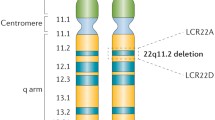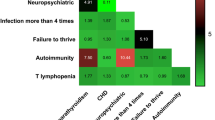Abstract
DiGeorge syndrome is characterized by conotruncal cardiac defects, hypocalcemia, and a hypoplastic thymus. Many, but not all, patients have a heterozygous deletion of chromosome 22q11.2. In its most severe form, it represents a devastating syndrome with high mortality. Patients with severe immunodeficiendy are candidates for a thymic transplant or a fully matched bone marrow transplant. Fortunately, the majority of patients with either DiGeorge syndrome or chromosome 22q11.2 deletion syndrome have a mild to moderate immunodeficiency. These patients may develop recurrent infections or autoimmune disease.
Similar content being viewed by others
References and Recommended Reading
Cooper MD, Peterson RDA, Good RA: A new concept of the cellular basis of immunity. J Pediatr 1965, 67:907–908.
Lischner HW, Huff DS: T-cell deficiency in DiGeorge syndrome. Birth Defects Orig Artic Ser 1975, 11:16–21.
Kelley RI, Zackai EH, Emanuel BS, et al.: The association of the DiGeorge anomalad with partial monosomy of chromosome 22. J Pediatr 1982, 101:197–200.
Kelley D, Goldberg R, Wilson D, et al.: Confirmation that the velo-cardiofacial syndrome is associated with haploinsufficiency of genes at chromosome 22. Am J Med Genet 1993, 45:308–312.
Driscoll DA, Budarf ML, Emanuel BS: A genetic etiology for DiGeorge syndrome: consistent deletions and microdeletions of 22q11. Am J Hum Genet 1992, 50:924–933.
Vincent MC, Heitz F, Tricoire J, et al.: 22q11 deletion in DGS/ VCFS monozygotic twins with discordant phenotypes. Genet Couns 1999, 10:43–49.
Kasprzak L, Der Kaloustian VM, Elliott AM, et al.: Deletion of 22q11 in two brothers with different phenotype. Am J Med Genet 1998, 75:288–291.
Yamagishi H, Ishii C, Maeda J, et al.: Phenotypic discordance in monozygotic twins with 22q11.2 deletion. Am J Med Genet 1998, 78:319–321.
Edelmann L, Pandita RK, Morrow BE: Low-copy repeats mediate the common 3-Mb deletion in patients with velocardio-facial syndrome. Am J Hum Genet 1999, 64:1076–1086.
Schuffenhauer S, Lichtner P, Peykar-Derakhshandeh P, et al.: Deletion mapping on chromosome 10p and definition of a critical region for the second DiGeorge syndrome locus (DGS2). Eur J Hum Genet 1998, 6:213–225.
Daw SCM, Taylor C, Kraman M, et al.: A common region of 10p deleted in DiGeorge and velocardiofacial syndromes. Nat Genet 1996, 13:458–460.
Van Esch H, Groenen P, Nesbitt MA, et al.: GATA3 haploinsufficiency causes human HDR syndrome. Nature 2000, 406:419–422.
Conley ME, Notarangelo LD, Etzioni A: Diagnostic criteria for primary immunodeficiencies: representing PAGID (Pan-American Group for Immunodeficiency) and ESID (European Society for Immunodeficiencies). Clin Immunol 1999, 93:190–197.
Goodship J, Cross I, LiLing J, et al.: A population study of chromosome 22q11 deletions in infancy. Arch Dis Child 1998, 79:348–351.
Devriendt K, Fryns JP, Mortier G, et al.: The annual incidence of DiGeorge/velocardiofacial syndrome. J Med Genet 1998, 35:789–790.
Hopkin RJ, Schorry EK, Bofinger M, et al.: Increased need for medical interventions in infants with velocardiofacial (deletion 22q11) syndrome. J Pediatr 2000, 137:247–249. This article clearly documents the complex and increased needs of patients with chromosome 2211.2 deletion syndrome.
Conley ME, Beckwith JB, Mancer JF, et al.: The spectrum of the DiGeorge syndrome. J Pediatr 1979, 94:883–890.
Markert ML, Hummell DS, Rosenblatt HM, et al.: Complete DiGeorge syndrome: persistence of profound immunodeficiency. J Pediatr 1998, 132:15–21.
Muller W, Peter HH, Wilken M, et al.: The DiGeorge syndrome: I: Clinical evaluation and course of partial and complete forms of the syndrome. Eur J Pediatr 1988, 147:496–502.
Barrett DJ, Ammann AJ, Wara DW, et al.: Clinical and immunologic spectrum of the DiGeorge syndrome. J Clin Lab Immunol 1981, 6:1–6.
Ryan AK, Goodship JA, Wilson DI, et al.: Spectrum of clinical features associated with interstitial chromosome 22q11 deletions: a European collaborative study. J Med Genet 1997, 34:798–804.
Motzkin B, Marion R, Goldberg R, et al.: Variable phenotypes in velocardiofacial syndrome with chromosomal deletion. J Pediatr 1993, 123:406–410.
McDonald-McGinn DM, Kirschner R, Goldmuntz E, et al.: The Philadelphia story: the 22q11.2 deletion: report on 250 patients. Genet Couns 1999, 10:11–24.
Eicher PS, McDonald-McGinn DM, Fox CA, et al.: Dysphagia in children with a 22q11.2 deletion: unusual pattern found on modified barium swallow. J Pediatr 2000, 137:158–164.
Swillen A, Devriendt K, Legius E, et al.: The behavioural phenotype in velo-cardio-facial syndrome (VCFS): from infancy to adolescence. Genet Couns 1999, 10:79–88.
Scherer NJ, D’Antonio LL, Kalbfleisch JH: Early speech and language development in children with velocardiofacial syndrome. Am J Med Genet 1999, 88:714–723.
Eliez S, Schmitt JE, White CD, et al.: Children and adolescents with velocardiofacial syndrome: a volumetric MRI study. Am J Psychiatry 2000, 157:409–415.
Wang PP, Woodin MF, Kreps-Falk R, et al.: Research on behavioral phenotypes: velocardiofacial syndrome (deletion 22q11.2). Dev Med Child Neurol 2000, 42:422–427.
Tobias ES, Morrison N, Whiteford ML, et al.: Towards earlier diagnosis of 22q11 deletions. Arch Dis Child 1999, 81:513–514. These authors attempt to identify clinical features to aid in the stratification of patients suspected of having chromosome 22q11.2 deletion syndrome.
Goldmuntz E, Clark BJ, Mitchell LE, et al.: Frequency of 22q11 deletions in patients with conotruncal defects. J Am Coll Cardiol 1998,32:492–498.
Rauch A, Hofbeck M, Leipold G, et al.: Incidence and significance of 22q11.2 hemizygosity in patients with interrupted aortic arch. Am J Med Genet 1998, 78:322–331.
Lu JH, Chung MY, Hwang B, et al.: Prevalence and parental origin in Tetralogy of Fallot associated with chromosome 22q11 microdeletion. Pediatrics 1999, 104:87–90.
Adachi M, Tachibana K, Masuno M, et al.: Clinical characteristics of children with hypoparathyroidism due to 22q11.2 microdeletion. Eur J Pediatr 1998, 157:34–38.
Kornfeld SJ, Zeffren B, Christodoulou CS, et al.: DiGeorge anomaly: a comparative study of the clinical and immunologic characteristics of patients positive and negative by fluorescence in situ hybridization. J Allergy Clin Immunol 2000, 105:983–987. This article addresses the important question of whether patients with the characteristic deletion have different clinical features compared with those who do not have the deletion.
VanEsch H, Groenen P, Fryns JP, et al.: The phenotypic spectrum of the 10p deletion syndrome versus the classical DiGeorge syndrome. Genet Couns 1999, 10:59–65. The authors determined that patients with the 10p deletion more frequently have deafness compared with patients with DiGeorge syndrome who do not have the 10p deletion.
Muller W, Peter HH, Kallfelz HC, et al.: The DiGeorge sequence: II: Immunologic findings in partial and complete forms of the disorder. Eur J Pediatr 1989, 149:96–103.
Bastian J, Law S, Vogler L, et al.: Prediction of persistent immunodeficiency in the DiGeorge anomaly. J Pediatr 1989, 115:391–396.
Junker AK, Driscoll DA: Humoral immunity in DiGeorge syndrome. J Pediatr 1995, 127:231–237.
Pierdominici M, Marziali M, Giovannetti A, et al.: T cell receptor repertoire and function in patients with DiGeorge syndrome and velocardiofacial syndrome. Clin Exp Immunol 2000, 121:127–132. Although patients have depressed T-cell numbers, their repertoire is largely normal.
Sullivan KE, Jawad AF, Randall P, et al.: Lack of correlation between impaired T cell production, immunodeficiency and other phenotypic features in chromosome 22q11.2 deletions syndrome (DiGeorge syndrome/velocardiofacial syndrome). Clin Immunol Immunopathol 1998, 84:141–146. The T-cell deficiency is not significantly associated with other phenotypic features and is not restricted to those patients who have the "DiGeorge" phenotype.
Tuvia J, Weisselberg B, Shif I, et al.: Aplastic anaemia complicating adenovirus infection in DiGeorge syndrome. Eur J Pediatr 1988, 147:643–644.
Pinchas-Hamiel O, Engelberg S, Mandel M, et al.: Immune hemolytic anemia, thrombocytopenia and liver disease in a patient with DiGeorge syndrome. Isr J Med Sci 1994, 30:530–532.
Ham Pong AJ, Cavallo A, Holman GH, et al.: DiGeorge syndrome: long term survival complicated by Graves disease. J Pediatr 1985, 106:619–620.
Sullivan K, McDonald-McGinn D, Driscoll D, et al.: Juvenile rheumatoid arthritis-like polyarthritis in chromosome 22q11.2 deletion syndrome (DiGeorge anomald/velocardiofacial syndrome/conotruncal anomaly face syndrome). Arthritis Rheum 1997, 40:430–436.
DiPiero AD, Lourie EM, Berman BW, et al.: Recurrent immune cytopenias in two patients with DiGeorge/velocardiofacial syndrome. J Pediatr 1997, 131:484–486.
Duke SG, McGuirt WF Jr, Jewett T, et al.: Velocardiofacial syndrome: incidence of immune cytopenias. Arch Otolaryngol Head Neck Surg 2000, 126:1141–1145. This is a wonderful study characterizing the frequency and clinical correlates of autoimmune disease in patients with chromosome 22q11.2 deletion syndrome.
Sullivan KE, McDonald-McGinn DM, Driscoll D, et al.: Autoimmune disorders in patients with chromosome 22q11.2 deletion syndrome (DiGeorge/velocardiofacial syndrome). J Pediatr 2000, submitted.
Sullivan KE, McDonald-McGinn D, Driscoll D, et al.: Longitudinal analysis of lymphocyte function and numbers in the first year of life in chromosome 22q11.2 deletion syndrome (DiGeorge syndrome/velocardiofacial syndrome). Clin Diagn Lab Immunol 1999, 6:906–911. There can be modest improvement in T-cell counts in the 1st year of life. This is most true for patients who present with CD3 counts less than 1300 cells/mm3.
Berend SA, Spikes AS, Kashork CD, et al.: Dual-probe fluorescence in situ hybridization assay for detecting deletions associated with VCFS/DiGeorge syndrome I and DiGeorge syndrome II loci. Am J Med Genet 2000, 91:313–317.
Moran AM, Colan SD, Mayer JEJr, et al.: Echocardiographic identification of thymic hypoplasia in tetralogy of fallot/tetralogy pulmonary atresia. Am J Cardiol 1999, 84:1268–1271.
Markert ML, Boeck A, Hale LP, et al.: Transplantation of thymus tissue in complete DiGeorge syndrome. N Engl J Med 1999, 341:1180–1189. This represents a major advance in the treatment of DiGeorge syndrome with severe immunodeficiency.
Markert ML, Kostyu DD, Ward FE, et al.: Successful formation of a chimeric human thymus allograft following transplantation of cultured postnatal human thymus. J Immunol 1997, 158:998–1005.
Smith CA, Driscoll DA, Emanuel BS, et al.: Increased prevalence of immunoglobulin A deficiency in patients with the chromosome 22q11.2 deletion syndrome (DiGeorge syndrome/velocardiofacial syndrome). Clin Diagn Lab Immunol 1998, 5:415–417. Although T cells are predominantly affected in this syndrome, humoral immunodeficiencies do occur.
Vantrappen G, Devriendt K, Swillen A, et al.: Presenting symptoms and clinical features in 130 patients with the velo-cardio-facial syndrome: the Leuven experience. Genet Couns 1999, 10:3–9.
Yan W, Jacobsen LK, Krasnewich DM, et al.: Chromosome 22q11.2 interstitial deletions among childhood-onset schizophrenics and "multidimensionally impaired." Am J Med Genet 1998, 81:41–43.
Frohn-Mulder IM, Wesby Swaay E, Bouwhuis C, et al.: Chromosome 22q11 deletions in patients with selected outflow tract malformations. Genet Couns 1999, 10:35–41.
Borgmann S, Luhmer I, Arslan-Kirchner M, et al.: A search for chromosome 22q11.2 deletions in a series of 176 consecutively catheterized patients with congenital heart disease: no evidence for deletions in non-syndromic patients. Eur J Pediatr 1999, 158:958–963.
Maeda J, Yamagishi H, Matsuoka R, et al.: Frequent association of 22q11.2 deletion with tetrology of Fallot. Am J Med Genet 2000, 92:269–272.
Loffredo CA, Ferencz C, Wilson PD, et al.: Interrupted aortic arch: an epidemiologic study. Teratology 2000, 61:368–375.
Webber SA, Hatchwell E, Barber JC, et al.: Importance of microdeletions of chromosomal region 22q11 as a cause of selected malformations of the ventricular outflow tracts and aortic arch: a three-year prospective study. J Pediatr 1996, 129:26–32.
Sugama S, Namihira T, Matsuoka R, et al.: Psychiatric inpatients and chromosome deletions within 22q11.2. J Neurol Neurosurg Psychiatry 1999, 67:803–806.
Perkins JA, Sie K, Gray S: Presence of 22q11 deletion in postadenoidectomy velopharyngeal insufficiency. Arch Otolaryngol Head Neck Surg 2000, 126:645–648.
Author information
Authors and Affiliations
Rights and permissions
About this article
Cite this article
Sullivan, K.E. Digeorge syndrome/chromosome 22q11.2 deletion syndrome. Curr Allergy Asthma Rep 1, 438–444 (2001). https://doi.org/10.1007/s11882-001-0029-z
Issue Date:
DOI: https://doi.org/10.1007/s11882-001-0029-z




